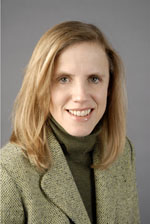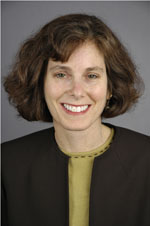Making Math Matter
September 27, 2011 - What if educators could teach their students math without ever having to respond to the question “Why do we have to learn this?”
A new middle school math curriculum developed by the Community-Based Mathematics Project of Philadelphia (CBMP2) just might make that possible. By using situations and contexts that students encounter in their daily lives to illustrate mathematical concepts, the “community math” curriculum engages students in learning math and encourages them to use their knowledge outside the classroom.
 Penn GSE professors Caroline Ebby and Janine Remillard along with doctoral students Vivian Lim, Luke Reinke, Emily Magee, Nina Hoe, and Maya Cyrus developed the community math curriculum, specifically tailoring it to teach Philadelphia’s middle school students. They discuss the CBMP2 curriculum in a recent article in Perspectives on Urban Education.
Penn GSE professors Caroline Ebby and Janine Remillard along with doctoral students Vivian Lim, Luke Reinke, Emily Magee, Nina Hoe, and Maya Cyrus developed the community math curriculum, specifically tailoring it to teach Philadelphia’s middle school students. They discuss the CBMP2 curriculum in a recent article in Perspectives on Urban Education.
“By inviting students into mathematics through contexts that are familiar and meaningful to them, we increase the opportunities for success,” they write. “Further, we emphasize that mathematics does have meaning in their lives.”
In 2003, the School District of Philadelphia adopted a curriculum called Mathematics in Context (MiC) as the citywide middle school math curriculum. MiC, developed by the Freudenthal Institute and the National Center for Research in Mathematical Sciences Education, uses imagined stories and situational contexts to teach math concepts like graphical analysis and geometry.
 But the MiC curriculum was giving Philadelphia teachers trouble: The contexts students were supposed to imagine – renting a motorcycle on an island vacation or hiking in the mountains, for example – were so foreign to these urban students that teachers often had to explain the real-world context before they could explain the mathematical concept.
But the MiC curriculum was giving Philadelphia teachers trouble: The contexts students were supposed to imagine – renting a motorcycle on an island vacation or hiking in the mountains, for example – were so foreign to these urban students that teachers often had to explain the real-world context before they could explain the mathematical concept.
“The likelihood of early difficulty increases when contexts are completely foreign to students,” the researchers say. “The context becomes a barrier, rather than a support for further mathematics learning.”
Using the MiC curriculum as a foundation, Ebby, Remillard, and their students worked with Philadelphia teachers to illustrate the same mathematic concepts using contexts their students could easily engage with both in and outside the classroom. Involving the teachers who would be using the curriculum served as a form of professional development, and also helped to ensure the curriculum addressed state standards and subject matter covered on standardized tests.
One lesson uses a map of the streets outside a particular school – streets that students travel every day – to teach them about angles and geometric relationships. Students, having a familiar entry point into the subject matter, became instantly focused and engaged in the lesson.
Another lesson asks students to compare cell phone plans. This situation – an easy one for middle school students to imagine – draws on the knowledge and experience students already possess to teach them about graphing data and comparing the results.
Beyond teaching basic math concepts and preparing students for standardized tests, though, the researchers saw the potential for a locally relevant math curriculum to do even more for students. Mathematical knowledge, they say, is highly valued in society and can help marginalized students both analyze and gain access to dominant cultural institutions. Teaching students math using familiar contexts not only increases their ability to understand and work with the material in school, but also increases the chance they will engage with and use math in their daily lives and have the tools to critically engage with their world.
Another lesson in the CBMP2 curriculum, for example, uses the high school application process in the School District of Philadelphia as a context for teaching students about graphic representations, sampling, coordinate planes, plane geometry, and probability – but the lesson also previews the application process, helping students understand what is expected of them and what the outcomes of their decisions might be.
Eighth grade students in Philadelphia can apply to special and selective high schools, many of which have higher graduation and college entrance rates than neighborhood schools – but many more students from middle-class communities apply to these schools than do students from low-income neighborhoods. Using demographic statistics, graduation rates, and college entrance rates for Philadelphia high schools allows students the opportunity to analyze this data and be more informed about their decisions and the institutions to which they have access
“The reality is that students often lack access to future opportunities simply because they do not understand the ways in which these institutions operate,” the researchers say. “By bringing to light potentially controversial issues and unfair practices, we create the space for students to use mathematics as a tool to understand and challenge their world.”
To hear Janine Remillard talk about mathematics teaching, click here.
